
Chapter Ten
TYPES OF AIRCRAFT PATROLS
A. TYPES OF PATROLS CURRENTLY IN USE.
B. CONTROL.
C. THE DAY COMBAT AIR PATROL (DCAP).
D. THE DAWN OR DUSK CAP (DADCAP).
E. THE NIGHT CAP (NCAP).
F. RESCUE CAP (SUBCAP) (BIRDCAP).
G. RADAR PICKET CAP (RAPCAP).
H. TARGET COMBAT AIR PATROL (TARCAP).
I. ANTISUBMARINE PATROLS (ASP).
J. AIR STRIKES AND SWEEPS.
K. BLANKET ATTACK OPERATIONS (BLANKET).
L. ANTISNOOPER ANTISUBMARINE PATROLS (SNASP).
M. LONG RANGE AIR SEARCHES DAY (DRECCO).
N. NIGHT INTRUDER UNIT (INTRUDERS).
O. NIGHT HECKLERS (HECKLERS).
P. PHOTO MISSION (GRAPHIC).
Q. PHOTO MAPPING MISSION (MAPHO).
R. BARRIER CAP (BARCAP).
--77--

Figure 69.
Chapter 10
TYPES OF AIRCRAFT PATROLS
A. TYPES OF CONTROL CURRENTLY IN USE
Aircraft are used offensively, defensively and on noncombatant tactical missions. "Patrols" as used here, refers to any flight, regardless of its mission.
This section outlines the standard offensive and defensive patrols in use today in carrier warfare. New patrols are frequently devised to meet new situations which arise. As naval tactics change, some of the established patrols may become obsolete and be discontinued. Definitions and abbreviations for the various patrols currently employed in the fleet are set out below:
I Day CAP (DCAP)--Fighters launched for combat air patrol during daylight.
2. Dawn or Dusk CAP (DADCAP)--Night fighters launched at dusk or dawn.
3. Night CAP (NCAP)--Night fighters launched for combat air patrol duty during darkness.
4. Bombardment Group CAP (BGCAP)-- Fighters launched as special cover for detached surface units.
5. Rescue CAP (SUBCAP)-- Fighters launched to assist and protect rescue submarine operations.
5A. (BIBDCAP)--Fighters used to cover aircraft employed on rescue missions.
6. Air strikes and sweeps--Powerful offensive missions made up of VF and VA in various combinations designed to destroy the enemy's offensive and defensive strength.
7. Blanket Attack Operation (BLANKET)--An offensive operation designed to neutralize enemy airfields and installations.
8. Target Combat Air Patrol (TARCAP)-- A combat air patrol similar in composition to the DCAP, designed to protect friendly forces in the objective or target area.
9. Radar Picket CAP (RAPCAP)--Fighters launched as combat air patrol for destroyer radar pickets or Tomcats.
10. Scouting Line CAP (SCOCAP)--VF or VFN stationed over a surface scouting line as combat air patrol.
11. LOWCAP (LOCAP)--Fighters launched to orbit at low altitude on assigned bearings
--79--
outside a surface formation to detect and destroy low-flying enemy aircraft.
12. Antisub Patrol (ASP)--A patrol flown by patrol units of varied compositon to detect and destroy submarines and low-flying enemy snoopers. Also known as SNASP.
13. Long Range Air Searches Day (DRECCO)--Long-range day search units, comprised of various combinations of aircraft.
14. Long Range Air Searches Night (NRECCO)--Long-range night search unit comprising two planes, one VF (N) and one VT (N) operating as a section and covering an assigned sector.
15. Night Intruder Unit (INTRUDERS)--A combat air patrol maintained over enemy airfields during darkness.
16. Night Hecklers (HECKLERS)--An attack unit of two to four VT (N) or VF (N) whose mission is to neutralize enemy airfields during darkness.
17. Photo Mission (GRAPHIC)--A routine photographic mission.
18. Photo Mapping Mission (MAPHO)--A photographic mission to obtain special mapping coverage of an area.
19. Weather Recco (WXRECCO)--Special weather flights.
20. Barrier CAP (BARCAP)--A barrier across the probable direction of approach of enemy aircraft.
The more important of the patrols listed above are discussed in detail in the following paragraphs. More detailed descriptions of all aircraft patrols and missions are set out in Carrier Task Force Tactical Instructions (USF4).
B. CONTROL
The control of all patrols rests with the OTC who is generally a task group or task force commander. Since radio is the principal means of communicating with airborne aircraft, CIC acts as a middleman between OTC and the pilots. Nearly all communications between pilots and OTC pass through CIC.
1. Functions of CIC Officer
It has been found that a considerable increase in efficiency results if the OTC delegates a maximum amount of air control authority to the CIC officer on his staff. The staff CIC officer in turn delegates responsibility to CIC officers on the individual ships. The most important responsibility of the CIC officer is usually the handling of the CAP in defense of fleet units.
2. Change of Mission
Any airborne plane may be diverted from the mission for which it was launched and given a different task when the need arises. For instance, fighters on ASP, strikes or searches may be, and frequently are, recalled and employed as a CAP for defensive purposes. Bombers on ASP can be formed into a small strike and ordered to attack enemy surface units. Any plane, regardless of type or mission, may be required to orbit survivors in the water and become a part of a search and rescue team. Ordering pilots to change their missions is done by the CIC officer with express authorization of the OTC.
C. DAY COMBAT AIR PATROL (DCAP)
1. Purpose
The day combat air patrol, commonly referred to as CAP, is a patrol of fighter aircraft flown primarily for the protection of friendly forces, afloat or ashore, against enemy air attack. The CAP may be drawn either from a land or a carrier-based squadron (s). Carrier task groups geenrally furnish their own CAP.
2. Composition
The four-plane fighter division is the present fundamental combat team. Divisions are'further subdivided into two-plane sections, but experience has amply demonstrated that the trained, two-section team of four is the most deadly and efficient fighting unit. Tactics and training are based on the concept that a division is the smallest element which should normally be employed for any combat task. Only under exceptional circumstances will CIC officers permit divisions to split up into their constituent sections.
It may become necessary for CAP flight leaders on their own initiative to split divisions, and even sections, in order to meet all enemy planes in a scattering attack. It must be clearly
--80--
understood that control of the CAP under such conditions is seriously impaired through the multiplicity of echoes and that successful defense rests to a very great extent on the unassisted efforts of the pilots themselves.
Six to 15 divisions comprise a fighting squadron. Squadrons receive a certain amount of training as a unit, but the bulk of it is aimed to produce efficient combinations of a smaller number of divisions.
3. Assignment of CAP
The size of the CAP is prescribed by the OTC in his operation order, but it may be modified by him as the situation changes. In the case of a carrier task group the patrol duty for the day may be assigned to a single carrier, or may be divided among several carriers.
4. Control
The CAP is under the control of the task force commander, who normally delegates this authority to the task group commanders. This delegation of authority normally moves from the task force CIC officer to the task group CIC officers. Each task group CIC officer keeps the OTC informed of the position, course, speed, and size of all unidentified targets and of what action is being taken.
When radar has picked up a bogey, it is the responsibility of the task group CIC officer to assign control of a portion of the CAP to a ship's CIC to effect interception.
The OTC may elect to launch additional fighters to augment the CAP in the event of a potentially heavy raidJ|All the fighters in the force are available in such an eventuality.% An arbitrary proportion of the available fighters will be in condition 10, that is, with pilots in their planes, engines warmed up and plane (s) on the catapult(s) when heavy enemy attacks are imminent; or a number equal to the airborne CAP will be maintained in Condition 11, that is, planes with engines warmed up, armed and gassed, spotted for launching and pilots in the ready room standing by. It usually requires several minutes notice to commence launching fighters in condition 11.
While it may appear that fighters in condition 10 are all that is necessary to defend the force, the high speed of aircraft and the rapidity with which an attack may develop makes an airborne patrol mandatory.
It is desirable that the CIC of the carrier whose planes are on patrol* control the interception. When this is not practicable, the CIC having the best information on the raid is given the job. Occasionally control may be shifted during the course of an interception, particularly when another ship has more complete information than the controlling ship. Frequently a CIC officer on a picket ship will be the logical controller, especially against an attack which his ship has been the first to detect.
In the case of long-range interceptions it is sometimes advantageous to shift control from one task group to another. In this connection when several task groups are tactically concentrated, the over-all defense of the force is coordinated by the task force CIC officer who may assign certain sectors of basic responsibility to each task group comprising the force.
5. Launching and rendezvous
The CAP is launched by the carrier having the duty in sufficient time to relieve on station. The first day CAP is generally launched at dawn (one-half hour before sunrise).
It must be remembered that planes flying independently prior to rendezvous have very little defensive value. Should it be necessary to commence an interception before the join-up has been effected, the CIC officer should inquire if any individual divisions are joined up and use such a division. In cases of extreme emergency planes may join up at random to form an improvised division and operate together as such.
The CAP after launching should rendezvous as quickly as possible, reporting to CIC when joined up.
"Mohawk, this is Mohawk One--Rendezvoused. Over."
"This is Mohawk--Roger. Out."
Generally in the briefing of the pilots they are informed of their station. When this has not been possible they must receive the information by radio from the CIC after take-off.
--81--
"Mohawk, this is Mohawk One--Rendezvoused. Request instructions. Over."
"This is Mohawk--Orbit base--Angels Ten. Over."
"This is Mohawk One--Wilco. Orbit base. Angels Ten. Out."
Often the CIC officer will wish to join up two divisions of the CAP which are at different altitudes.
"Mohawk Three, this is Mohawk. Join on Mohawk One at Angels Ten. Over."
"This is Mohawk Three--Wilco. Join on Mohawk One at Angels Ten. Out."
Experience dictates that when divisions are to be joined up for a patrol it can be done more expeditiously if they make their rendezvous in their assigned rendezvous sector prior to proceeding to station.
6. Detaching Division of CAP
If two or more divisions are in one flight and it is desired to send one or more divisions on a mission, while the remaining divisions stay on station, the separation will be achieved in the following manner:
MOHAWK 1, 2, and 3 are joined up orbiting base at Angels 10. It is desired to send MOHAWK 1 and 2 intercept a bogie and have MOHAWK 3 remain on station.
"MOHAWK 1 this is MOHAWK--Vector 090--Buster--Angels 10--MOHAWK 3 Detach and Resume--Over."
"This is MOHAWK 1--Wilco--Vector 090--Buster--Angels 10--Out."
"This is MOHAWK 3--Wilco--Detach and Resume--Out."
7. Stationing
The CAP is flown in the vicinity of the force it is covering. When there are indications that attack is probable from a certain direction, all or part of the CAP may be stationed on this bearing generally within sight contact of the group, but always in radio and radar range.
Altitude of the CAP is a very critical factor and must be such that the fighters are assured of an altitude advantage in meeting all enemy attacks. Since the range of radar is proportionate to the altitude of the target, groups of high-flying planes will be detected at a considerable distance, and during an interception the altitude of the CAP can be adjusted, if necessary.
It might appear that the ideal CAP altitude would be the ceiling of the aircraft being employed, but a very high patrol has definite disadvantages. Pilots must use oxygen masks above 10,000 feet and low temperature are encountered at higher altitudes. These factors cause a marked decrease in alertness and combat efficiency. Furthermore, a high CAP makes an excellent target for enemy radars and may indicate to the enemy the position of the task group.
A special situation arises when large land masses appear on the radar screen. In this case, high-flying attacks may be initially detected at short range, and a high CAP is essential for adequate protection. The CAP at high altitude (20,000 feet or above) is also necessary to combat the tactics of high-flying, high-speed reconnaissance aircraft and suicide planes.
One of the most difficult types of attack to intercept is the low-flying attack which is initially detected at 30 miles or less from the task group. These planes are usually 2,000 feet or less above the water and must be countered with a low patrol since it is very difficult to sight a low-flying plane from high altitudes. When the CAP consists of several divisions, at least one division may be kept at a low altitude for this purpose.

Figure 70.
8. Interceptions
Interceptions are controlled by a controllei designated by the CIC officer. He controls the CAP until they report "tallyho." When this contact is made, the flight leader takes over completely. During the engagement the controller exchanges only the most vital information with the combat team, bearing in mind
--82--
that he must obtain "splash" and "heads up" information from the CAP.
When the enemy attack is dispersed or destroyed, fighters should immediately rendezvous and request further orders. It is imperative that the CAP stations be reassigned as the tactical situation dictates, in preparation for any subsequent attack.
After they have rendezvoused, they will report to the controller who will give them further instructions. The CAP should report their "state."
"Mohawk, this is Mohawk One. Fuel 150, Ammo Plus. Over."
"This is Mohawk. Understand Fuel 150, ammo plus. Out."
If the controller has another bogey to intercept, he will give the CAP another vector. If he desires them to return to station, he will so order them, giving them a "steer" to fly to bring them back to base.
"Mohawk One, this is Mohawk. Steer 1-6-0. Over."
9. Other uses
The primary purpose of CAP is defensive-- to protect friendly forces from attack, but the CAP may be used for other purposes,
(a) Part of the CAP may be used for a highspeed search when action with the enemy is imminent and his location is not known exactly. This search would be ordered by the OTC who would designate the size of the CAP to be detailed for such a task.
(b) If a plane goes in the water, the low section CAP may be ordered to orbit the position of the downed personnel until the OTC can detail a destroyer or other rescue facility to pick them* up.
(c) The low CAP acts as a high surface lookout.
(d) The CAP may act as a radio relay station.
(e) The CAP may be used to investigate surface contacts.
(f) The CAP may be used to obtain weather information.
10. Emergency landings
If for any reason any member of the CAP deems it inadvisable to continue the flight, he should report the fact to the controller (or he may report this to the division leader first who then relays it to the controller). The controller will take whatever action is necessary. If it is something that is within his control, he will advise the troubled pilot what to do. If it is something beyond his scope, he should immediately advise the appropriate officers (OCT, captain, or air officer) and await instructions.
If a plane requests permission to make a forced landing, the pilot should state the length of time he can remain airborne so that the bridge may be informed and determine whether there is time to respot, turn into the wind, or consult the OTC for instructions.
One plane by itself is an easy target for enemy fighters whereas a division, or section, presents a tight defensive organization. The controller should bear this in mind when he has instructed a plane in trouble to return to base. It is always advisable to have the wingman accompany him.
11. Pancaking
It is very important to land the CAP on time. If there is any variation from the schedule, the captain of the ship and the task group CIC officer should be informed so that the turn into the wind may be delayed and time out of formation minimized.
In giving landing instructions to the CAP, "Prep Charlie" is used to instruct them to enter landing circle. They are normally given "Char-lie" by blinker, which means the ship is ready to receive them and they can commence approach. The average duration of a CAP is 3% to 4 hours.
12. Radio check
It is presumed that when the planes leave the deck their radio gear has been checked and is in good operational order. No radio check is made with the CIC until they are air-borne, and this is usually done when they are rendezvoused and/or on station. The manner of radio checking may vary with task groups or even with carriers within a group, but its chief purpose is to insure good communications with the division and the section leader.
The number of radio checks should be kept
--83--
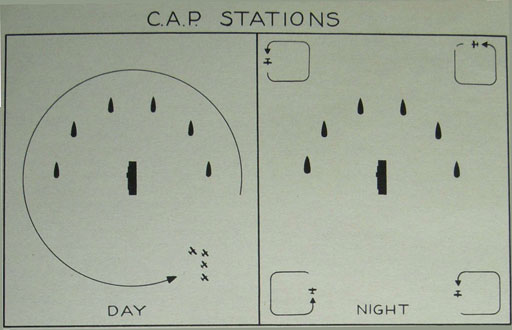
Figure 71.--Day and night CAP stations.
to a minimum so as to leave the channel clear for priority messages.
13. Radio failures
If, in a one-division CAP, the flight leader's radio fails, he should relinquish the command to some other experienced pilot in the flight, generally the second section leader. If the flight leader fails to respond immediately to the controller's order, the wingman calls "Mohawk this is Mohawk 1--2. Mohawk 1--1's radio is out, over" and at the same time he pulls up alongside the leader and hand signals radio failure. The section leader is then designated by the controller to reverse sections and assume the lead. If his radio goes out, the lead will then be given to the next most reliable pilot. The controller will, when necessary, designate a new division leader when the original division leaders radio has failed.
14. Weather
As shown on page 37, the CAP gives its base the weather in the area they are flying. This will be reported as often as necessary to keep the CIC fully informed of the weather conditions aloft.
15. Plane to plane communication
The planes in a division communicate with each other by visual methods when practicable, thereby avoiding much unnecessary traffic on the radio channels.
D. DAWN AND DUSK COMBAT AIR PATROL
(DADCAP)
1. Purpose
The twilight period between daylight and night, either in the morning or the evening, is the time when ships are most vulnerable to air attack. There is a short period both at dawn and dusk when the light is such that planes can make effective attacks, en masse, against ships, but the ships and also fighter aircraft have difficulty in sighting the attacking planes.
The dawn period is a favorite time for the enemy to attack, since he may be able to get
--84--
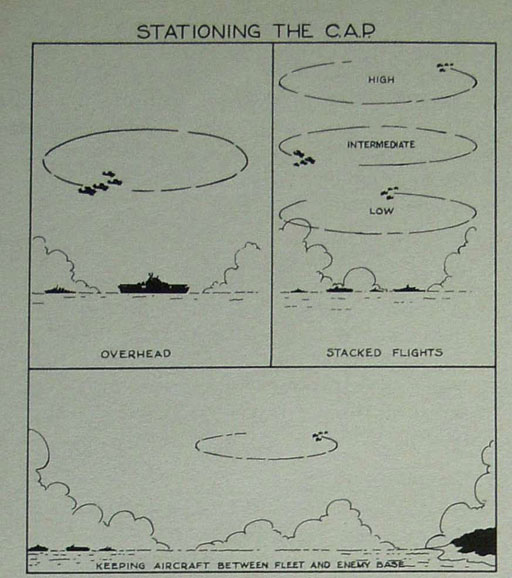
Flgure 72.--Stationing the CAP.
in before the carriers are able to launch their day CAP. An effective attack might, in fact, force the ships to take a down-wind course and prevent their launching planes even after dawn.
The DADCAP is used for protection during these periods.
2. Composition
The DADCAP consists of one or more divisions of night fighters.
3. Employment
The DADCAP requires a combination of day and night techniques.
The dawn CAP is launched so as to be on station at least 1 hour before sunrise. They are stationed as a night CAP until conditions of light become such that they may be joined up and used as a day CAP. The first day CAP relieves the dawn CAP on station.
The dusk CAP relieves the last day CAP so that the latter may be landed by sunset. At the appropriate time the dusk CAP is usually split up and stationed at separate points as a night CAP.
In making an interception with the DADCAP the controller must determine the most effective type of control to use as dictated by the visibility. The opinions and suggestions of the pilots are of much value to him in this connection.
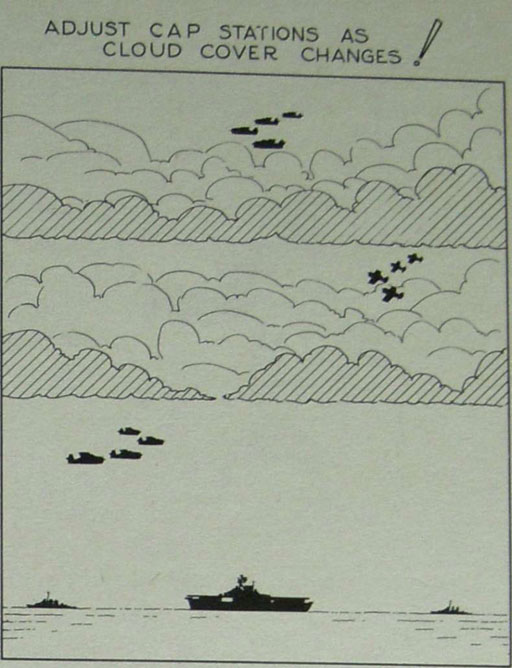
Figure 73.--Clouds and CAP stationing.
4. Landing
The dawn CAP is landed by normal day procedure, while the dusk CAP must use night procedure. In ordering the planes to land the signal bridge gives the dawn CAP a "Charlie"
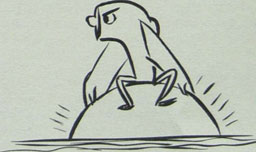
Figure 74.--DADCAP.
--85--
by blinker, while the controller must give the dusk CAP a "Charlie" by radio and direct them into the traffic circle using the night fighter carrier controlled approach system.
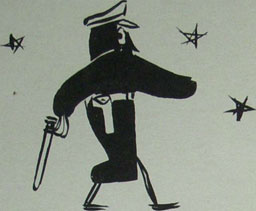
Figure 75.
E. NIGHT COMBAT AIR PATROL (NCAP)
1. Purpose
The principal function of the night CAP (NCAP) is the protection of friendly forces against enemy air activity during hours of darkness. They may, in addition, be used to make surface searches, bring home lost planes, or to act as a radio relay station. Night fighters are also used to make weather hops through overcasts, and with DCAP'S for cloud interceptions.
2. Composition
The NCAP should be composed of a number of specially designed, radar-equipped fighter planes flown by qualified night pilots. Due to the increased difficulties of control, the size of the NCAP is considerably less than that of the day CAP. Night fighters may be flown in sections, or even divisions, but individual VFN each under positive close control are normally used.
3. Employment
The night CAP may be launched whenever night attacks or snoopers are considered likely; or the planes may be kept on deck until a bogey actually appears on radar and then launched. The greatest value of the NCAP is in the destruction of snoopers or small groups of enemy planes and in breaking up larger raids. Because of poor visibility it is extremely difficult to shoot down all of a large group of attacking planes. Frequently, however, the effectiveness of the attacks can be drastically lessened by destroying one or two key planes which lead the attack.
4. Launching
The NCAP is usually launched by catapult since this method is safer and permits the flight deck to be spotted forward so that the planes can be landed with very little respotting. It is not necessary for ships in the formation to show any lights while the NCAP is being launched.
5. Control
Prior to take-off the pilots are assigned a rendezvous station. Immediately after take-off the planes proceed to their assigned stations and rendezvous.
There are several methods used in stationing NCAP. The individual planes may be orbited at widely separated positions; they may be employed as two-plane sections; or an entire division may be joined up. The orbit points are usually out of gun range of any ships, and also located so as to be visible at all times on the radar screen.
The control of NCAP is flexible. It can be handled by its own CIC, other CIC's in the task group, or control may be passed from group to group or to a qualified destroyer out on a picket station.
Technique of interception with the NCAP is discussed at length in the chapter on night interceptions.
6. Landings
The restriction on visibility at night makes it necessary for the night controller to exercise a high degree of control over his NCAP. One of the night controller's most important functions is to bring the planes in to the landing aide using the carrier controlled approach system. Control is continued using this system until the pilot sights the landing signal officer and passes to the latter's control. In order to
--86--
reduce the danger of midair collisions, not more I than two night fighters should be in the landing circle simultaneously. Generally some or all of the ships of the formation will show truck lights to indicate their position to the planes during night landings. See USF 8 and Chapter 20 part II this book.
7. Communications
Good communications with every plane of the night CAP is essential. To insure proper performance VFN are equipped with two complete VHF/UHF sets. Each plane makes a radio check on both while still on deck and again immediately after take-off.
When a plane's radio fails, the plane must be landed as soon as possible. If necessary, another plane should be employed to lead the plane in question into the landing circle.
NCAP's are often used for radio relay purposes and act as a VHF/UHF link between task groups which are not tactically concentrated.
8. Night fighter radar
Night fighters are equipped with a special radar for interception work. The set is designed for detecting aircraft, but the equipment is also valuable to the pilot in making a surface search and in maintaining his proper station.
F. RESCUE SUBMARINE SEAPLANE COMBAT AIR PATROL (SUBCAP) (BIRDCAP)
1. Purpose (SUBCAP)
During air strikes against fixed enemy objectives one or more submarines are customarily assigned the task of rescuing personnel from planes which are forced down in the water near the target. When possible, a CAP is supplied to each submarine for the following purposes:
1. To afford air protection for the submarine.
2. To act as a high lookout and guide the submarine to downed personnel.
3. To act as a radio relay station.
4. To minimize shore fire by strafing, in event of submarine rescue near enemy beach.
2. Composition
The usual makeup of the SUBCAP is two or four fighter planes.
3. Employment
The SUBCAP generally is supplied by one of the carriers in the striking task group(s). The normal station is in the vicinity of the submarine at such an altitude as to obtain the optimum visual surface coverage. On receiving a downed personnel report, the nearest submarine proceeds to the position indicated and the CAP makes a search of the area. When the survivors have been sighted, the CAP leads the submarine to the spot either by visual or radio signals. If it is necessary to attempt a rescue within range of enemy gun fire, the CAP may be required to make continuous attacks on the gun positions until the submarine has effected rescue and is out of danger.
4. Control
En route to and from station, the SUBCAP is under control of the task group CIC. The SUBCAP, like any other team of fighters, may be diverted from its original mission and used as a normal CAP when necessary. While on station the SUBCAP is under control of the submarine through visual or radio communication. Submarine radar is such, however, that controlling the CAP in making interceptions is not generally practicable.
5. Communication
Standard VHF/UHF and HF rescue frequencies are designated on which all survivor reports are made. All submarines in rescue work are suitably equipped to cover both channels. The SUBCAP must rely messages to the sub, and must keep the OTC informed of the sub's activities. This includes the names and condition of all rescued personnel.
6. Purpose (BIRDCAP)
During rescue operations where seaplanes are employed in the rescue, a cover of fighter aircraft will be furnished. These aircraft will afford protection for rescue aircraft and forward rescue information to the controlling station.
7. Composition
The usual makeup of the BIRDCAP is two or four fighter aircraft.
--87--
8. Employment
The BIRDCAP is generally supplied by one of the carriers in the striking group, and shall accompany rescue aircraft to the scene of rescue and protect both down personnel and rescue aircraft until rescue is completed or until ordered to return to base Ijy the coordinator of search and rescue.
G. RADAR PICKET COMBAT AIR PATROL (RAPCAP)
1. Purpose
The radar picket combat air patrol (RAP-CAP) is a CAP assigned to cover a radar picket ship, "Tomcat" or "Watchdog." Its functions are as follows:
1. The RAPCAP orbits the radar picket or "Tomcat" at an altitude sufficiently high to check returning strike planes as they make their identification orbit around the picket ship. This visual check is designed to detect and eliminate any enemy aircraft which might be trailing groups of returning strike planes.
2. It serves to protect the picket ship from air attack.
3. It is used to investigate and intercept bogey contacts, under control of the picket ship CIC.
2. Composition
The RAPCAP is usually composed of from one to four divisions of fighters, depending on the tactical situation. During the hours of darkness one or two night fighters may be assigned to the control of the picket ship CIC.
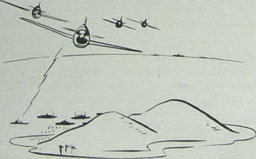
Figure 76.
3. Employment
The RAPCAP is launched by a carrier group (unit) (ship) and is under the control of the ship designated by the TGCICO, while en route to and from station.
While on station the picket's CIC takes control and employs the RAPCAP in the manner most appropriate for their task and for their own defense. The planes may also be used as radio relay stations for the pickets.
H. TARGET COMBAT AIR PATROL (TARCAP)
1. Purpose
The target combat air patrol (TARCAP) is a patrol identical in organization with the CAP, which is flown over an enemy objective under attack by friendly forces. Its size depends on the amount of air opposition expected and the number of fighters available. The purpose of the TARCAP is to clear the areas of enemy aircraft which might attempt to disrupt the attack or to counterattack our surface forces.
2. Control
When there is a base, ashore or afloat, sufficiently near the objective with the necessary facilities for fighter direction, it may control the TARCAP. Often, however, the pilots must rely on their own vision together with reports from attacking forces in the vicinity.
3. Secondary functions
The TARCAP reports to the OTC the location of any survivors of plane crashes which have not been reported by the strike planes. They may also be required to direct rescue facilities to the downed personnel. The TARCAP may launch bombs and/or rockets before taking station or, after being relieved, join in the attack prior to returning to their base.
In the absence of a target coordinator, the TARCAP keeps the OTC informed of the situation at the target. This includes:
(a) Weather reports. A detailed knowledge of weather over the objective is necessary in determining the most effective type of attack to deliver.
(b) Progress of the strike and assessment of damages. An assessment of the damage inflicted enables each strike leader to choose the
--88--
most profitable targets without delay. The decision by the OTC to discontinue the attack and withdraw may be partly based on reports from the TARCAP.
4. Duration
It is desirable to have the TARCAP relieved on station, but when the base supplying the patrol is at a considerable distance from the target, this policy necessitates numerous flights. The pilots are informed before take-off of the length of time they are expected to remain on station. They must keep a careful check on their fuel, and must have enough when they arrive at the base to carry them through a short unexpected delay in landing. Thus it is sometimes necessary for the TARCAP to leave station without being properly relieved.

Flgw 77.
I. ANTISUBMARINE PATROL (ASP)
1. Purpose
The primary mission of the antisubmarine patrol, or ASP, is the detection and destruction of enemy submarines in the vicinity of friendly ships. The ASP supplements and extends both the visual and radar coverage of the task group. In addition it can effectively attack enemy surface units and can detect and occasionally destroy low-flying enemy aircraft.
2. Composition
ASP is a patrol giving 360° coverage at intermediate ranges and may be flown in equal sectors or its coverage may concentrate in the direction of movement of the task group. The plan used is determined by the OTC in accordance with the tactical situation, and each pilot is informed prior to take-off of the sector he is to
cover. The sectors are covered by single planes, VA armed with depth charges and carrying machine guns and sometimes rockets as secondary armament. If insufficient (VF) VA are available, fighters may be used, but these are less effective. In some cases fighter aircraft, VF, are assigned to the ASP's for augmentation of the VA aircraft patrol and for destruction of low flying aircraft or "snoopers." The usual station of these VF aircraft is slightly behind and about 500 feet above the VA.
3. Employment
The ASP is flown concurrently with and usually from the same ship as the CAP. It is under control of the launching ship although tracking responsibility may be assigned to any ship in the task group. All contacts are immediately reported to the OTC, and he will prescribe a course of action. When an enemy contact has been reported, a part or all of the ASP may be ordered to join in the attack, and sometimes the CAP can be of assistance depending on the nature of the contact. If the contact is a submarine close to the task group, one or two units of the screen may be ordered to work with the ASP and form a hunter/killer team. In this event the screen units and the planes exchange information and the detection gear and heavier armament of the ships are employed to their fullest advantage. The ASP is not usually employed on strike days by the fast carriers.
4. Responsibility of CIC
CIC has the responsibility of knowing the position of each plane on ASP at all times. The normal ASP altitude is approximately 1,500 feet at which height the planes can be continuously tracked by the task group radars. When it becomes necessary for the planes to fly at a lower altitude, due to cloud or sea conditions, CIC keeps an accurate DR plot of all planes not appearing on the screen. When a contact is made, the estimated position is given by the pilot, and this is checked by the plane's position on the plot. The CIC officer is then in a position to direct other aircraft to the target.
When several task groups are tactically concentrated, it becomes difficult to keep track of
--89--
the individual ASP planes. To decrease the resultant confusion, a task force ASP is flown. In this case the planes from one task group may give coverage to the entire force or each group may be assigned a sector to patrol.
5. Coordination with CAP
If the ASP sights a low-flying enemy plane which has escaped radar detection, the pilot will immediately turn on emergency IFF to verify his position. The air controller will then coach CAP to the scene of the contact with the assistance of the ASP pilot.
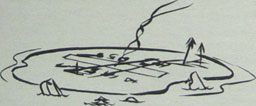
Figure 78.
6. Communications
ASP is assigned a VHF/UHF channel with an HF frequency for secondary use. The individual planes may or may not make radio checks with the base depending on the condition of radio silence in effect and the amount of traffic on the channel. Usually severe restrictions are placed on use of HF, and it is only to be employed in an emergency and when VHF/UHF communications cannot be established. CAP can be quickly shifted to ASP frequency when close coordination between the patrols is required.
7. Radar
VA type aircraft carry search radar which increases the effectiveness of their search, especially in low visibility. In addition, the radar serves as an aid to navigation and helps the pilot to stay in his assigned sector.

Figure 79.--Four plane ASP pattern.
8. Launching and landing
ASP planes are relieved on station which means the relieving plane must be in the proper sector, but need not necessarily make visual COn-
tact with the plane it is relieving. On the return leg of each sector sweep the planes approach close enough to the task group so that visual identification is possible by the ships in the formation. After being relieved they return to the task group, join up, and await orders by blinker to land. Planes from the ASP are frequently used to orbit over personnel in the water until they are rescued by a destroyer from the formation.
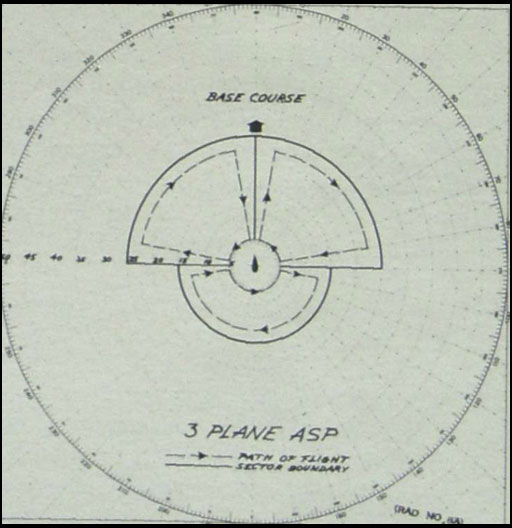
Figure 80.--Three plane ASP pattern.
--90--
J. AIR STRIKES AND SWEEPS
1. Mission
An air strike is a major offensive effort carried out by a group of planes assigned to inflict damage on an enemy target ashore or afloat.
2. Composition
A strike group may consist of any combination of VF and VA. The principal weapons available to carrier aircraft are bombs, incendiaries, torpedoes, rockets, depth charges, and machines guns. If the need arises, fighters from a strike group may be recalled and used as a normal CAP.
3. Employment
The exact composition of a strike and the armament to be carried are determined by the OTC in accordance with the nature of the target. The strike pilots are briefed prior to takeoff on all available information concerning the objective. They are given the necessary navigational data, such as the course and speed of "Point Oboe," bearing and distance of the target, time of take-off, estimated length of time over the target and ETA. They are thoroughly indoctrinated in rescue procedure.
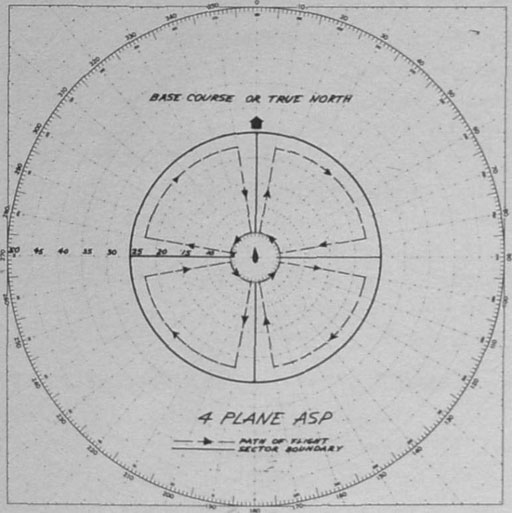
Figure 81. Four plane ASP pattern.
4. Launching
In launching a large number of planes from a task group as in a strike, the problem of rendezvous may be difficult. Explicit instructions are essential in order to avoid confusion and delay, and the ACI Officer will brief the pilots prior to take-off according to the plan drawn up by the strike leader. The planes from each carrier are assigned a sector and an altitude at which to join up. As each carrier group is rendezvoused, the fact is reported to the strike leader by the individual leaders. The strike leader then joints up the groups to form the strike and takes departure. During predawn launches destroyers are sometimes stationed in each sector with distinctive lighting arrangements to serve as reference points for the various groups.

Figure 82.--Five plane ASP pattern.
5. Target Coordinator
It is frequently found expedient to maintain a one or two plane patrol over the objective, the lead pilot acting as target coordinator. The target coordinator is usually an air group commander from one of the striking carriers. It is his task to assign targets to and coordinate the strikes, keep the OTC informed of the weather conditions over the target at all times, and furnish a running account of the progress of the strikes and an assessment of damages to be passed on to the OTC. If the target coordinator discovers, for instance, that there are no
--91--
ships in a harbor whereas intelligence reported otherwise, he so informs the OTC in order that the loading of following strikes can be changed accordingly. The target coordinator's evaluation of the military value of the objectve is taken into consideration by the OTC in deciding when to augment, change, or discontinue the attack.
6. Control
Strikes are under the tactical control of the strike leaders en route to and from the target. While they are in the objective area, they are under control of the target coordinator. On arrival at the objective the strike leader reports to the target coordinator giving the number of planes in his strike and the armament carried. He then leads the attack as instructed, rendezvous bis,group and takes them back to the base. If no target coordinator is assigned a designated strike leader takes over his duties.
7. Function of CIC
The principal duty of CIC in connection with strikes is the relaying of information. All information concerning the situation at the target must be reported to the OTC. When the course or speed of "Point oboe" is changed, the strike leader must be notified. ITC must receive all survivor reports that are made. When a returning plane reports that it is damaged, the captain of the parent carrier must be informed of the fact. In addition CIC will frequently be called upon to home lost planes. Further, CIC is responsible for keeping the OTC or the task group commander informed of the location of strike groups at all times. This information may be based on a radar fix or on the dead reckoned position of each strike group.
In order to maintain a continuous flow of pertinent information CIC must at all times have a comprehensive picture of the progress of a strike group. For this purpose a large" scale geographic chart of the area should be used on a horizontal plot with the location of all target areas, rescue reference points, rendezvous points, and similar information clearly laid out. Routes to and from the target may be drawn in and all flights should be dead reckoned thereon when they move out of radar range.
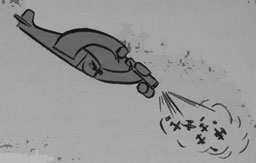
Figure 83.
8. Fighter Sweeps
When heavy enemy air opposition is expected at the target, the first strike may consist entirely of fighters and is called a fighter sweep. The purpose of the fighter sweep is the destruction of all enemy planes which might provide opposition for the strikes that are to follow and of enemy bombers which might constitute a threat to the carrier task groups.
9. Communications
Carrier strikes can be made against targets at any distance up to about 300 miles from the task group. In the majority of cases the target is between 75 and 125 miles distant. At this range VHF/UHF communications between the base and planes over the target are fairly reliable if the planes have sufficient altitude. When direct communications cannot be established, any of the patrols in the vicinity of the task group may be used for relay purposes, or special planes may be launched to do so. Picket ships have proved helpful in this function.
It is frequently desirable to employ HF for plane-to-plane communications in the target area. This serves to reduce congestion on VHF/ UHF channels without loss of security. In addition, the ships of the task group and other interested activities can listen in on the circuit and learn the progress of the strike.
K. BLANKET ATTACK OPERATIONS (BLANKET)
Blanket operations are normally conducted against enemy land-based air forces where it is desired to inflict maximum damage to enemy aircraft and at the same time prevent enemy air operations from fields in the areas under
--92--
attack. The smothering effect of the Blanket attack method is obtained by use of the "Three strike" system under which each carrier group maintains one strike at the target, another en-route to the target, and the third rearming on deck. This is an OFFENSIVE operation, not simply a patrol over the target.
Each operational airfield (or system of fields) is assigned to a flight of strike aircraft, the size of the flight depending upon the expected opposition (including A A opposition). The "Three strike" system is designed to permit pilots to remain in their assigned area until arrival of the next strike and give them time to hunt out camouflaged or hidden aircraft and to conduct intermittent frag bombing, rocket and straffing attacks on carefully selected targets. Obviously pilots sent to distant fields will not be able to remain over the target until the arrival of the next strike; however, a time gap of 20, 30 or even 40 minutes at the target may not give the enemy time enough to mount an attack with his aircraft widely dispersed.

Figure 84.
L. LONG RANGE AIR SEARCHES DAY (DRECCO)
1. Purpose
Long-range air searches are flown to give visual and/or radar coverage of a sector extending several hundred miles from a force or base. Land bases in the advanced areas launch daily searches to cover areas where the enemy might be found. Carrier-based searches are flown when there is a possibility of enemy forces being in the area or when information or photographic intelligence concerning an enemy land base is required.
2. Composition
Carrier searches are generally laid off in sectors originating at the group center, each sector being of a width which permits complete
visual or radar coverage at the outer limits of the search. The composition of search units varies greatly depending on plane availability and the probability of encountering enemy forces. One or two VA with or without VF escort is the usual search group, but when contact with major enemy units is expected, each search group may constitute a small strike in itself. The latter reinforced group is known as a REDRECCO.
3. Communication
The OTC is kept informed, communications permitting, of all enemy contacts made by the searches. Since searches may be flown out to 400 miles from the base VHF radio is inadequate for reporting contacts from the outer limits of the search. This difficulty can be overcome by using lower frequencies or by stationing VHF/UHF relay planes every hundred miles along the median of the search sector.
4. Employment
The leader of a search group may elect to attack an enemy contact if such a course of action is consistent with his previous instructions In deciding whether or not to attack, the leader must bear in mind the importance of covering the rest of the search sector, the strength of the enemy, the fuel on hand, the distance from the base, and the armament available.
5. CIC in Control of Searches
Search pilots are assigned calls and sectors to cover prior to takeoff.
After launching the groups rendezvous and report their time of departure by VHF/UHF when conditions of radio silence permit. CIC then tracks each group by radar until it fades from the screen. After radar contact is lost the planes are dead reckoned until they reappear on the screen on their returning leg.
If a contact is reported, CIC can make a fairly accurate estimate of its position from the dead reckoned track of the reporting plane.
To aid CIC in identifying returning planes, the pilots usually report their ETA when they are in VHF/UHF range.
Because searches are flown over a great distance, variable winds and changes of course by
--93--
the task group often render it difficult for the returning planes to find their base. For this reason it is of paramount importance that both the pilots and CIC personnel be well versed in homing procedure. CIC should have the plans, including sectors, calls and types of planes, for all land based searches which might be encountered. When a radar contact is suspected to be a land based search, it can be identified by its track and position. This can be checked by calling the plane on assigned frequency.
Exampie: (From search dispatches 7 Victor Mohawk Baker is supposed to be in the vicinity of the force (group).)
"7 Victor Mohawk Baker, this is Mohawk. Over."
"Mohawk, this is 7 Victor Mohawk Baker. Send your message. Over."
"This is Mohawk. What is your course, speed and Angels. Over."
"This is 7 Victor Mohawk Baker. Course 028° speed 168. Angels seven. Over."
"This is Mohawk--Roger. Out."
This information is then evaluated against the track in CIC for confirmation. If further confirmation is required, the plane may be told to make an alteration in course or one 360° turn.
M. NIGHT INTRUDER
1. Purpose
The night intruder is a CAP maintained over an enemy airfield during darkness. The Intruders harass enemy planes attempting to take off, inform OTC when enemy planes are airborne, and keep OTC advised of the weather in the target area.
2. Composition
An intruder unit will normally consist of two night fighter planes.
3. Employment
Prior to take-off the pilots are briefed on the position of the target with respect to the ship, the expected movements of the task group during the patrol, and latest information concerning enemy airfields.
The night fighters' radar may be of use to the pilots in finding their target, but it cannot be used to detect planes taking off. The patrol has little value unless the visibility is such that pilots can see the planes on the ground.
Except in rare cases, the intruders will not be directed by CIC in a controlled intercept while they are in the target area.
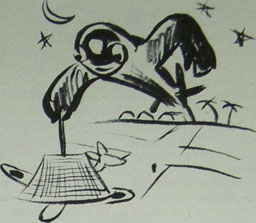
Figure 85.
N. NIGHT HECKLER MISSIONS
1. Purpose
The purpose of hecklers is the continuation during the night of a daytime attack against an enemy area. The planes attack at regular intervals throughout the night in an attempt to keep the enemy in a state of disorganization. Some material damage will be inflicted, but the greatest value of the hecklers is psychological.
2. Composition
The heckler mission usually consists of two to four VF (N) 's or VA (N) 's.
3. Employment
The pilots are thoroughly briefed prior to take-off on their mission. The planes will carry bombs regardless of whether VF(N) or VA(N) are employed. It is desirable to have a heckler patrol on station throughout the night The patrols should therefore relieve on station and each patrol should make intermittent attacks throughout the time they are on station. In order to decrease the interval between attacks the VA(N) sometimes carry a number of small bombs rather than one large one. If light
--94--
conditions permit, the hecklers may strafe as well as bomb.
CIC exercises control over the hecklers only while they are en route to and from their station.
O. PHOTO MISSION (GRAPHIC)
1. Purpose
The purpose of a photo mission is to get photographs in order to obtain information concerning an enemy objective or to assess the damage done by an attack.
2. Composition
The photo mission consists of one or more specially equipped fighter planes which may or may not be accompanied by fighter escort.
3. Employment
The pilots are given a definite area which they are to photograph and are instructed as to the type of photographs desired. When weather conditions prevent their getting the required photos, they have previously assigned alternate areas to photograph or they may contact OTC via CIC and request a new target.
CIC may be called on to home the photo missions.
P. PHOTO MAPPING MISSION (MAPHO)
1. Purpose
The MAPHO mission is flown in order to get precise photographs of a given area so that a map of the terrain can be made from them.
2. Composition
The mapho mission usually consists of two to four specially equipped fighter planes escorted by a division of fighters.
3. Employment
Specially trained pilots are usually employed for MAPHO. The patrol is very similar to photo except that a great deal more precision is required.
Q. BARRIER CAP (BARCAP)
1. Purpose
The BARCAP is an added protection for the task force (group) against raids that use the most direct route of approach.
2. Composition
The BARCAP will usually consist of one or more divisions of fighter aircraft.
3. Employment
The BARCAP is employed between the force and the objective area as a barrier across the probable direction of approach of enemy aircraft, and as far from the force requiring protection as satisfactory radio communications and other considerations will permit. Normally the BARCAP will be employed to intercept raids which are not surprise attacks, but raids that have as their only mission the sustaining of damage to the forces with no intentions of returning to an enemy base.
--95--
Table of Contents
Previous Chapter (9)
Next Chapter (11)

















